North American Decoys at Auction
April 24th, 2014
|
Dating from the last quarter of the 19th century, the approximately 31" long hollow-carved slot-neck Canada goose sold for $632,500. Guyette & Deeter’s detailed catalog entry notes who found it and where, the make of a crosspiece, the intended use for the decoy, details on the decoy’s removable head, the dates and locations of previous sales, etc., plus literature, including page numbers. At Sotheby’s January 2000 McCleery sale, it sold for $233,500. Guyette & Deeter photo.
Jon Deeter calls this drake by the Mason Decoy Factory in Detroit, Michigan, a holy grail of collecting. Premier grade, it couples the rarest species with the highest grade of the factory. The only hollow-carved example known to exist, it is in superb condition. No wonder it was top lot at $690,000, setting a world auction record for the factory maker. It brought $354,500 at the McCleery sale at Sotheby’s in January 2000. Guyette & Deeter photo.
This curlew made by the Mason Decoy Factory in the last quarter of the 19th century sold for $6900. According to Deeter, the Migratory Bird Treaty Act of 1918 ended the hunting of curlews, also ending one market in decoys. This bird is marked “W.P.” on the underside. Guyette & Deeter photo.
The preening canvasback deserves extra respect as a senior among decoys. Made in the third quarter of the 19th century, it is, said Deeter, “getting very old for decoys.” It was carved by Albert Laing, who had a market selling ducks at the Fulton Fish Market in New York City, and it is thought that the $34,500 decoy was part of his rig.
A fine carving of hanging game by Cameron McIntyre of New Church, Virginia, was front and center at the preview. Carved of native white cedar and painted in oils, it brought $27,600. The artist is unusual for his popularity in the secondary market.
The Winchester poster called “The Cock of the Woods,” 25½" x 15½", brought $6037.50. Colors remain bright. Guyette & Deeter photo.
|
|
|
Guyette & Deeter, St. Charles, Illinois
We’d never seen Maine auctioneer James Julia in action, so when he assumed the podium at the April 24 and 25 Guyette & Deeter sale of North American decoys in St. Charles, Illinois, we were in for a surprise.
Julia is a brilliant entertainer and patter performer. If the bottom ever falls out of the auction biz, he can segue to Las Vegas. Once he had the audience warmed up, prices flew. Obviously, bonhomie goes a long way toward opening wallets.
Our favorite was at open where he launched into a long riff on “If you lost a twenty-dollar gold piece encrusted with diamonds, with a large emerald in the middle, et cetera—don’t see me. I don’t have it.” All that was setup for a public service announcement on a found brooch.
On a more prosaic level, the result for the two-day sale of almost 700 lots topped $3.6 million (with buyers’ premiums). Three lots sold for over $100,000, and 47 sold for over $10,000.
Co-owner Gary Guyette called the sale “our largest decoy sale since April 2007 and the fifth ever dollar-wise. Big items were pretty much what we expected.” He also spotted continued weakness in the prices of less desirable decoys and added, “The crowd was larger than usual.”
I’ll say. There wasn’t a seat left in the large auction room at Pheasant Run Resort in St. Charles, a northwest suburb about an hour from Chicago. The only vacant seats had reserved tags, placed the day before by known buyers. Guyette and partner Jon Deeter understand their buyers and allow the dibs.
To understand how well they know buyers, consider that the large annual auction does not happen in St. Charles simply because it is a lovely community. According to Guyette, it is because the city is centrally located. Few bidders are from the area.
St. Charles works because it is convenient to airports and highways for collectors from Canada, the Midwest, and mid-South. Smaller sales happen in Portsmouth, New Hampshire (to reach East Coasters), and Charleston, South Carolina (access to a younger crowd).
Guyette pointed out differences between decoy buyers and the standard antiques market. In the antiques market, most auction buyers hunt for resale. Decoy bidders are there to buy for their pleasure. Others are upgrading. At the core, they are free of concerns about prices and maintaining objectivity.
Decoy bidders are “a retail crowd, more affected by what’s going on about them,” he said. That explains the head swivels we saw during the sale as higher bids came out of nowhere. Here, one can get carried away by emotion and bid higher than planned.
Guyette and Deeter’s understanding of decoy collectors extends to the fact that auctions are carefully choreographed. It’s a delicate dance, assuring that blockbusters aren’t clustered and that big-ticket items appear toward the front of a sale.
Sensitive to his bidders, Guyette added, “You give them space.”
Space brought big sales, especially on the first day, when the sale’s top lot, a circa 1910 wood duck drake from the Mason Decoy Factory of Detroit, Michigan, brought $690,000 (includes buyer’s premium). Earlier in the sale, a hollow-carved Canada goose from the last quarter of the 19th century sold for $632,500.
In catalog listings for each, provenance took twice as much space as description. For serious decoy collectors, of course the carver or maker is paramount. But buyers also want to know where the decoy came from, who discovered it, plus the roster of previous owners (collections) and sales. Significant personalities in decoy history matter in this genre.
The golden standard in current provenance is if the decoy was part of the January 2000 estate sale of decoys collected by Dr. James McCleery. That sale was mounted by Guyette and Schmidt (then co-owners) at and with Sotheby’s, and the decoys, part of an almost $11 million sale, famously included a sleeping Canada goose by Elmer Crowell that brought $684,500, then a record for a decoy at auction.
In the April sale catalog, Guyette and Deeter photographed the McCleery/Sotheby’s lot number on the bottom of the Mason Factory duck.
Another highlight was an unusual blue jay perched on a branch, circa 1920, by Elmer Crowell. Estimated at $16,000/20,000, it sold for $59,800.
Sharing a catalog page with the jay, the next lot did not fare as well. Estimated at $1500/2000, an Elmer Crowell redhead drake’s head on a chamfered wooden platform from the first quarter of the 20th century sent Julia into a string of humor about redheads, including a poke at nearby retired staffer Dudley Browne: “You like redheads, don’t you Dudley?” Failing to rouse bids, Julia asked, “How about five hundred dollars?” That did it, and the redhead went for $750.
Later, when a bidder dropped out, he chided, “What a quitter.” Of course, he knew the bidder, and there’s another difference.
The world of decoy hunters is fraternal. Everyone present seemed to know each other, and to our eye they were 98% male, with a few wives along for the trip.
Guyette explained it this way: “Most people don’t come into serious decoy collecting until they’re forty-five or fifty-five years old and done paying for houses, cars, and college.” And ready to indulge their interest.
“We’re getting more and more new people,” he added. “The economy is recovering in certain demographics, and top decoys are doing better.”
As for trends, he observed that “Mason duck decoys are down now because so many are on the market. Wait and that will change.”
Partner Jon Deeter thinks the sale “continues to reinforce the bifurcation of the market.” Decoys of high quality, with great condition and provenance, did well. Those with condition problems or by second- or third-tier makers did not.
“I love forty-five- to fifty-year-old starting collectors,” he added. “They have years of buying ahead of them.” And they come with a pent-up hunger already in place.
“Look at the growth of Cabela’s and Duck Dynasty,” he replied. “I’m not concerned about new buyers.” And he thinks the new cohort is more comfortable buying at auction than from dealers.
“Auctions set and know current market price,” he continued. Guyette and Deeter’s guarantee also helps. “Each item gets a condition report, and we guarantee that it is what we say it is. It is not a statement of opinion,” said Deeter.
If the buyer later disagrees, “We take it back. No questions asked.” Phone buyers especially like that feature.
For more information, contact Guyette & Deeter at (410) 745-0485, Web site (www.guyetteandschmidt.com).
Originally published in the July 2014 issue of Maine Antique Digest. © 2014 Maine Antique Digest






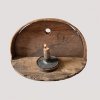











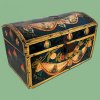
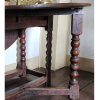



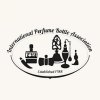



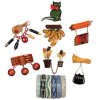
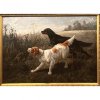












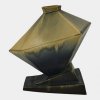

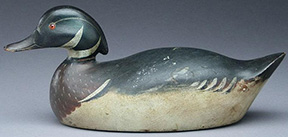



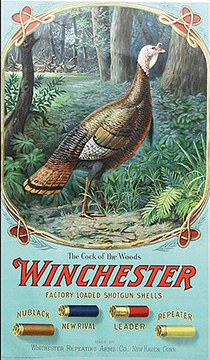
 This circa 1930 carved duck call with a red mouthpiece by Charles Perdew of Henry, Illinois, sold for $5750. It is carved with the initials of the owner, also of Henry. Guyette & Deeter photo.
This circa 1930 carved duck call with a red mouthpiece by Charles Perdew of Henry, Illinois, sold for $5750. It is carved with the initials of the owner, also of Henry. Guyette & Deeter photo. This hollow-carved full-size great horned owl with original paint by Jerry Siloski, circa 1970, was in a cluster of contemporary decoys, and it sold for $1150.
This hollow-carved full-size great horned owl with original paint by Jerry Siloski, circa 1970, was in a cluster of contemporary decoys, and it sold for $1150. 



